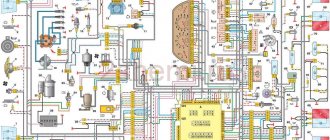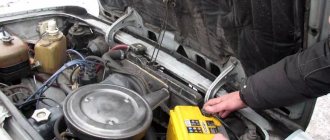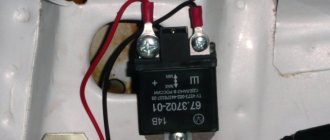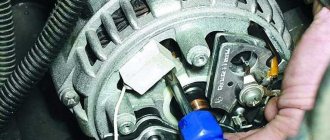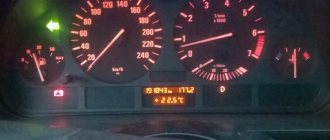Print this article Font size 16
If the generator stops charging, there is nothing good about it. It is necessary to immediately begin searching for the cause of such a malfunction. Otherwise, all your electrical equipment will be without power, and the battery will soon run out completely.
If the generator works well, then the battery will not need additional charging with special devices for many months, sometimes even years. The battery will consistently retain at least 60% charge. Thus, the batteries are constantly replenishing their charge reserve through the operation of the generator.
Appearance of the device
There is no charging from the generator on the VAZ 2110, what should I do?
If the generator stops charging, there is nothing good about it.
It is necessary to immediately begin searching for the cause of such a malfunction. Otherwise, all your electrical equipment will be without power, and the battery will soon run out completely. If the generator works well, then the battery will not need additional charging with special devices for many months, sometimes even years. The battery will consistently retain at least 60% charge. Thus, the batteries are constantly replenishing their charge reserve through the operation of the generator.
Appearance of the device
What is on the VAZ 2110
For VAZ 2110 cars, the installation of two types of generators is provided, depending on the installed engine.
- For carburetor models, a generator with number 9402.3701 is installed.
- If the engine is injection, then the catalog number of the generator used will be 3202-3771. It has a serpentine belt.
Regardless of the type of installed engine and generator, respectively, problems with the devices are the same, therefore the inspection and repair procedure is identical in both cases.
Malfunctions
There are two main reasons why an alternator stops charging properly.
Cause
Peculiarities
This happens to those who like to install numerous additional equipment that is powered by a generator, that is, it requires electricity. These could be speakers, electric pumps, video devices, etc. A standard generator is not designed for such loads, and therefore loses efficiency
Battery and alternator mismatch
To ensure the operation of electrical equipment additionally installed on the car, many decide to install a more powerful battery with a standard generator. A mismatch in power leads to the fact that the generator ceases to provide proper charging to the more powerful battery. So he simply does not have enough resources for this
What charge does the generator produce?
Many people are interested in the question of how much a generator should produce for normal operation.
Here the parameters directly depend on the current state of the car.
- If the engine is cold and just turns on, then the voltage will normally be 14.1-14.4 Volts;
- If you check the voltage after long trips in traffic jams, then the generator will produce less, about 13.9-14.1V.
Recommendations
Comments 12
I have 13.6 on XX without consumers (
Most likely the diode bridge needs to be replaced!
It’s difficult to change it, I’m not talking about disassembling and removing the generator, but can I solder the bridge itself?
No. I changed the bridge without removing the generator and everything was fine, everything was on the screws and terminals. I have 8kl engine. It’s better to remove the generator, remove the diode bridge, go to the store with it and they will give you the same one
I have the same problem... Gen 21214(80a) but I didn’t change the diode bridge... it gives 13.8
I changed the diode bridge and everything was resolved, the device checked it as working, but I decided to try changing it and guessed right...
hahahaha 30 amp generator hahahaha))))
at 80, then I took a closer look. the inscription is erased...
Change the bridge, it's cheap!
The check light is probably indicating that there was an open circuit in the power supply; this happens when the voltage disappears (I removed the battery and unscrewed the wiring from gene 2). Drop and score. And your voltage is low, possibly due to contamination. Use sandpaper to go through all the places where they are tightened with bolts, especially sand the ends of the cylinder that leads “+” to the wires. I had this problem because of its rustiness. If there is no protection and the gene is constantly watered, then these problems will haunt you constantly, either contacts or bearings. Shut up completely))))
Thanks for the advice! The crankcase protection is large with side corners, the generator is relatively clean. The problem was partially solved, I replaced the slip rings, cleaned all the contacts under the bolts... and at the same time changed the bearings. Now, until the brushes have gotten used to it, at idle it shows 13.7, both under load and without load. at the generator it's about 13.8. I cleared the error and it no longer appears. I’ll soon post an article on how I did everything...
Constant undercharging of the battery is a big problem that results in many troubles for the car owner.
- Firstly, such a battery often has to be recharged manually from a stationary charger, which gets boring quite quickly.
- Secondly, when the battery is regularly in a discharged or semi-discharged state, an irreversible process of sulfation of the plates occurs in it, due to which the capacity and starting current are reduced.
- Thirdly, such a battery can fail at any time, usually at the most inopportune time.
Finding and eliminating the cause of chronic undercharging of the battery is quite easy in normal garage conditions. The main thing is to know where to dig. There are several such reasons, and almost all of them are described in detail in this material. Including, in clear words, it is explained what undercharging is, under what conditions it occurs, for what reasons, and how to diagnose these very reasons with your own hands.
Troubleshooting
Lack of charging can be caused by a wide range of reasons, which we will talk about today.
These reasons include:
- Weak contacts;
- Winding breaks;
- Short circuit on the rotor housing;
- Interturn short circuits;
- Mechanical breakdowns;
- Closing the positive clamp on the body;
- Short circuit in the phase winding;
- Short circuit of the stator to the housing.
Let's look at these situations in more detail to determine the true cause of the breakdown specifically in your case.
Start by turning off all additional equipment in your car that is not included as standard - DVR, navigator, audio system, etc.
Next, we perform the following operations.
- Measure the current output when the vehicle is cold, not running and all life support systems are disconnected. If there is no return at all, that's good. But this rarely happens. Almost always on tens there may be insufficient contact, some kind of short circuit, due to which there is recoil, but it is small. It’s much worse if the recoil is impressive and leads to battery discharge in one night spent in a parking lot or garage.
- If everything is normal, there are no strong current leaks or they are insignificant, and the battery has retained its charge, then you can return all the devices to the places that were installed additionally.
- Recheck the recoil. If at the same time the instruments show an active leak, then the reason does not lie in the battery and is not related to the generator. The culprit of the problem is one of the additionally connected devices.
- If no recoil is observed, then you need to carefully inspect the generator.
- There are many sources of trouble that can lead to generator failure. These include:
- Insufficient contact between the rotor rings and brushes;
- There was a break in the excitation winding;
- An interturn short circuit has occurred on the field winding coil. In this case, the generator will hum and get very hot;
- The field winding closes to the rotor housing;
- The stator shorts to the housing;
- A break occurs in the stator phase winding;
- The diodes have broken through in the rectifier block, that is, the diode bridge;
- The plus is shorted on the body;
- Mechanical problems have occurred.
Next, we will take a closer look at each of the reasons presented above.
Disassembled unit
Problem solving
- Poor contact. Loose contact can occur due to contamination, oil getting on the brushes, slip rings. Also, contact may deteriorate due to shrinkage of the springs that press on the brushes, or the brushes are stuck. Such phenomena lead to an increase in excitation resistance and can sometimes break the circuit. To eliminate the problem, sometimes it is enough to simply treat the surfaces with a rag soaked in gasoline. If the brushes are worn out, it is better to replace them. At the same time, check the condition of the springs and rings. The rings oxidize, so treat them with glass sandpaper.
- The winding has broken. If this happens, the battery will no longer charge. To determine the problem, place your hand on the battery. If there is a break, the device will begin to heat up. If you want a more accurate check, then disconnect the end of the field winding from the brush and connect the battery wires to it and terminal Ш using a voltmeter or a light bulb. If there is a break, the lamp will not light up and the voltmeter needle will not budge. Test each coil individually to determine which one is preventing the alternator from working. The internal coils must be replaced, and the internal coils must be soldered.
Unit diagram
- Short circuit between turns. An interturn short circuit can occur in any field winding coil. If such a situation occurs, the winding will begin to heat up, and the excitation current will increase. To check, be sure to measure the resistance of each coil. For this you will need a voltmeter.
- Short circuit on the rotor housing. Such a breakdown leads to the fact that the entire field winding is short-circuited. The generator stops working. The most common short circuit area is where the ends of the winding lead to the rotor rings. To check, use a 220V light bulb. One wire should be connected to any contact of the ring, and the second to the rotor core or shaft. If there is a short circuit, then the light will turn on. It is impossible to operate a car with such a generator. It is necessary to isolate or completely replace the faulty winding. The first option is only suitable for getting to a service station and carrying out a full repair.
- Short circuit on phase winding. This kind of problem occurs because the insulation between the turns of the stator coil is destroyed. If this happens, the generator will start to get very hot, the battery will not receive sufficient charge, as this happens at high crankshaft speeds.
- Short circuit of the stator to the housing. As is the case with the other listed short circuit options, in this situation the generator begins to overheat, hum, and its power drops significantly. To check you will need a 220V light bulb. One wire is connected to the core, and the second to the winding terminal. Any. If there is a short circuit, your light bulb will light up. To fix the problem, simply replace the failed coil.
- The positive terminal closes to the housing. This kind of malfunction is unpleasant because it does not just overheat your generator. Also, due to this short circuit, breakdown of the diodes of the rectifier unit occurs. From there, the problem goes to the battery, which can simply short out. Not infrequently, a short circuit led to complete failure of the battery. Although most often it just completely discharges.
- Mechanical problems. If we take into account all possible mechanical problems of the generator, then belt stretching will be in first place in terms of frequency. This is the most common breakdown in the case of the VAZ 2110. If this happens, the pulley will begin to seriously overheat and the battery will not have enough charge. It is not superfluous to check the quality of all contacts, the presence of broken connections and other possible mechanical problems.
If problems are detected with the generator, you should immediately begin measures aimed at eliminating the breakdown. If you have no experience, contact only trusted service stations.
The alternator is the heart of your vehicle's electrical system. Like the main human organ, it provides power to all instruments and devices. Therefore, you should treat it very carefully and if problems arise, do not delay repairs.
Replacing the diode bridge
To replace the relay regulator and the rectifier unit (another name is a diode bridge), you need to disassemble the generator, first removing it from the VAZ 2110, for which you will need 13, 10 keys and a Phillips screwdriver.
To remove the generator you need to:
- Disconnect the battery terminals;
- Remove the rubber cap on the generator and unscrew the nut securing the wires with a 10 mm wrench;
- Pull out the connector;
- Loosen the tension mechanism nut, unscrew the tension bolt and remove the bracket;
- Move the generator with the mounting tool, loosen the belt and remove it;
- Using a 13mm socket, unscrew the 3 bolts from below and remove the generator along with the lower bracket.
For further work, the back cover is removed; it is held in place by 3 plastic latches. Use a Phillips screwdriver to unscrew two screws and remove the relay combined with the brush assembly. To remove the rectifier unit, you need to unscrew the 4 screws securing it and the capacitor, as well as the ends of the windings.
The relay can only be replaced as a whole; there are several models on sale, even with a “summer-winter” switch for selecting the output voltage. It is also better to replace the diode bridge as an assembly.
The generator on the VAZ 2110 does not charge for reasons
The generator in a car converts mechanical energy into electrical energy. After starting the car, the generator starts working and charges the battery, as well as all electrical equipment installed on the car.
The generator is located under the hood and is driven by the crankshaft. Sometimes it may happen that the generator on the VAZ 2110 does not charge. This can lead to a blackout of the car and after some time of movement of the car, it will no longer be able to move.
Where is the VAZ 2110 generator located?
If the generator is working properly, then you should not periodically recharge the battery with external chargers. It must work properly for a long time, charging only from the generator. The battery should always have 50-60% reserve charge.
For the VAZ 2110 car, two types of generators can be used. If the car is carburetor, then the generator number will be 9402-3701. If the car is fuel injected, then the generator number is 3202-3771. Although they are not particularly different from each other, the nature of their malfunctions is the same.
For example, on a VAZ 2110, the 8-valve injector does not charge the generator, for only a few reasons:
The vehicle has an excessive amount of equipment that supplies more electricity. These could be additional speakers, audio/video devices and various pumps and vacuum cleaners. A conventional generator cannot cope with such a load and therefore stops properly supplying charge to the battery.
generator and battery do not match. If the car has a lot of additional devices installed that require electricity, then the owner installs a more powerful battery. Explaining this by the fact that a more powerful battery will be enough to operate all third-party equipment. But in fact, the VAZ 2110 generator will produce little charge, the reason is that it will not be enough for a strong battery.
When the generator of a VAZ 2110 car does not charge, there may be other reasons. The generator may be damaged mechanically. Contacts oxidize over time. Somewhere they may simply come off; poor fastening of the wires can also lead to a malfunction of the generator. You need to pay special attention to the rotor. Since on the rotor body, a short circuit may occur.
Causes of breakdown of the VAZ 2110 generator
In order to identify the cause of a generator malfunction, it is necessary to consider all possible options for its failure separately.
- First, one by one, you need to turn off all digital devices. Radio, DVR, navigator, speakers.
- After everything is turned off, the car is not started and warmed up, it is necessary to measure the current output. The mark should be at zero. The higher the mark, the faster the car battery will drain. Even overnight it can discharge to zero. If the indicator is good, you can reconnect everything, and then check the current output again.
- The problem may lie in the connected devices themselves. If the indicators are normal, then you need to carry out a full diagnosis of the generator itself.
- The cause of a generator malfunction may be a short circuit in the stator, damage to the field winding, breaks, or a loss of connection between the working elements in the generator. But there is always a solution, you just need to know what to do.
- If it's still a bad connection. The connection may be broken due to oil getting on the brushes or rings. Also if the brushes hang, if the springs have settled. Sometimes this problem can be solved simply by wiping everything with gasoline. And sometimes it is impossible to do without replacing spare parts that have already worn out. If the rings are oxidized, they must be cleaned with sandpaper.
- The generator may not work due to a winding break. Then the battery does not receive any charging at all. Checking this is as easy as shelling pears, put your hand on the battery, if it gets warm under your hand, it means there is a break.
- Interturn closure. At any time, the winding may start to heat up and the coils will fly, so you need to check all the coils individually using a voltmeter.
- Short circuit on the rotor housing. Due to the short circuit, a general short circuit of the entire winding occurs and the entire unit stops working. To check the malfunction, just take a light bulb and wires. Connect them to any contact and to the rotor. If the light comes on, it means there is a short circuit. Afterwards it is necessary to completely replace the entire winding.
- Short circuit in winding phase. If a short circuit occurs, the generator will become very hot and the battery will remain without charging.
- Stator bridging. The generator will also heat up. A hum and various sounds appear. Again, you can check it using a light bulb and wires. The solution to the problem is the usual - replacing the coil.
- Mechanical failure of the generator. If the pulley on the generator overheats, the charge drops and the battery receives little charge. First of all, you need to diagnose all contacts and look for the broken one.
Other reasons why the generator on the VAZ 2110 does not charge
If the problem is not in the generator, but the charging light is on on the panel, you need to make sure that the light on the device and the fuse are working properly.
- You need to try replacing the fuse, starting the car and checking the dashboard. If the light does not light, then the problem was in the fuse; the generator does not need to be touched.
- Sometimes the belt may break along the way. It wears out quickly, so you should always carry a spare one with you, since you can change it at any time and continue driving the car. Sometimes the belt may simply become loose and less charge will be supplied to the battery. You just need to tighten the belt by adjusting it, and the problem will be eliminated.
- If the car is used continuously, the battery should be changed after about three years. But don’t forget about the generator, which can accelerate battery wear. Because of this, various devices and electrical equipment will fail. Therefore, it is necessary to observe the generator with special attention.
Winding break
If the excitation winding is broken, then there is no charging of the battery. To determine this, it is often enough to place your hand on the generator. When it breaks, it heats up. For an accurate check, you need to disconnect the end of the excitation winding from the brush, connect the battery wires to it, and connect the battery wires to terminal Ш of the generator (via a voltmeter or a light bulb).
If there is a break, the voltmeter needle will not deflect and the light bulb will not light up. To find which of the coils prevents the generator from working, connect the wires from the battery to each individually. Finally, check the soldering and coil terminals. If the break is internal, the coil needs to be replaced; for external ones, soldering helps.
The charging voltage on the VAZ 2110 floats
VAZ (Lada) 2110 1995 - 2007
I check with a multimeter on the battery and generator the charge is 13.7, and when connecting diagnostics it shows the on-board voltage 10.5. Sometimes it drops to 8. The car does not run smoothly, the speed jumps, and there are misfires. What could it be?
- Checking the battery charge from the generator in a VAZ 2110 – 5 answers
- Why does the generator produce low voltage, VAZ 2110? – 4 answers
- The diode bridge of the VAZ 110 burned out - 4 answers
- The diode bridge in the VAZ 2110 burns out - 3 answers
- VAZ 2110 stalls when you turn on the heater - 3 answers
Maybe your multimeter is lying? But at a voltage of 10 volts there may be problems, check the generator in this case. But before using this multimeter, even if it’s lying, measure the voltage with the car not running, and then with the car running. If the difference with the engine running is a couple of volts higher than when the car is not running, then the generator is working and you need to look for the reason for the poor performance elsewhere.
You checked the generator and battery with a multimeter, this is the correct voltage, although it is close to the lower charging limit of the generator.
When diagnosing, you see on the computer the voltage that the engine controller shows. Well, since it differs from direct measurements on the battery and generator, it means your 13.7 volts simply do not reach the “brains”, that is, they are lost somewhere. Most likely, in some place the wire is shorted to ground (although of course in this case the fuse should burn out, but there are cases that the fuse can withstand a small load) or the wires are shorted together. There may be another case, the contacts are simply rusted or oxidized, let’s say the “ground” points, the resistance at such points increases, the current passes with difficulty, and so there is insufficient voltage. It is quite possible that it passes there in impulses, and this is the result - “the speed jumps and the ignition misfires.” Or alternatively: the contact on the ECU connecting block may have loosened. You can start checking there. The controller is located near the front passenger's left foot behind the plastic panel
Where did you do the diagnostics? A good auto electrician-diagnostician will usually tell you where to look for a fault. And a really good one will also find this malfunction and fix it (of course this will cost money).
Troubleshooting
A lot depends on the operation of the VAZ 2110 generator. If it malfunctions, what can start the battery? And when it stops providing the required voltage, you have to urgently figure out what the reason is. But just by external signs you can determine that the generator is creating problems:
- The charging light starts flashing at low speeds;
- there may be a burning smell in the cabin;
- there are mechanical damages.
If a visual inspection does not bring results, you must:
- remove the plastic cover from the generator;
- check all electrical connections;
- Unscrew the diode bridge, as well as the voltage regulator relay with brushes.
Diodes are checked with a special tester. When they operate normally, the current will only flow in one direction. If the current flows in two directions or the diodes do not pass it at all, then the reason has been found.
The generator on the VAZ 2110 does not charge for reasons
The generator in a car converts mechanical energy into electrical energy. After starting the car, the generator starts working and charges the battery, as well as all electrical equipment installed on the car.
The generator is located under the hood and is driven by the crankshaft. Sometimes it may happen that the generator on the VAZ 2110 does not charge. This can lead to a blackout of the car and after some time of movement of the car, it will no longer be able to move.
Where is the VAZ 2110 generator located?
If the generator is working properly, then you should not periodically recharge the battery with external chargers. It must work properly for a long time, charging only from the generator. The battery should always have 50-60% reserve charge.
For the VAZ 2110 car, two types of generators can be used. If the car is carburetor, then the generator number will be 9402-3701. If the car is fuel injected, then the generator number is 3202-3771. Although they are not particularly different from each other, the nature of their malfunctions is the same.
For example, on a VAZ 2110, the 8-valve injector does not charge the generator, for only a few reasons:
- The vehicle has an excessive amount of equipment that supplies more electricity. These could be additional speakers, audio/video devices and various pumps and vacuum cleaners. A conventional generator cannot cope with such a load and therefore stops properly supplying charge to the battery.
- generator and battery do not match. If the car has a lot of additional devices installed that require electricity, then the owner installs a more powerful battery. Explaining this by the fact that a more powerful battery will be enough to operate all third-party equipment. But in fact, the VAZ 2110 generator will produce little charge, the reason is that it will not be enough for a strong battery.
When the generator of a VAZ 2110 car does not charge, there may be other reasons. The generator may be damaged mechanically. Contacts oxidize over time. Somewhere they may simply come off; poor fastening of the wires can also lead to a malfunction of the generator. You need to pay special attention to the rotor. Since on the rotor body, a short circuit may occur.
Causes of breakdown of the VAZ 2110 generator
In order to identify the cause of a generator malfunction, it is necessary to consider all possible options for its failure separately.
- First, one by one, you need to turn off all digital devices. Radio, DVR, navigator, speakers.
- After everything is turned off, the car is not started and warmed up, it is necessary to measure the current output. The mark should be at zero. The higher the mark, the faster the car battery will drain. Even overnight it can discharge to zero. If the indicator is good, you can reconnect everything, and then check the current output again.
- The problem may lie in the connected devices themselves. If the indicators are normal, then you need to carry out a full diagnosis of the generator itself.
- The cause of a generator malfunction may be a short circuit in the stator, damage to the field winding, breaks, or a loss of connection between the working elements in the generator. But there is always a solution, you just need to know what to do.
- If it's still a bad connection. The connection may be broken due to oil getting on the brushes or rings. Also if the brushes hang, if the springs have settled. Sometimes this problem can be solved simply by wiping everything with gasoline. And sometimes it is impossible to do without replacing spare parts that have already worn out. If the rings are oxidized, they must be cleaned with sandpaper.
- The generator may not work due to a winding break. Then the battery does not receive any charging at all. Checking this is as easy as shelling pears, put your hand on the battery, if it gets warm under your hand, it means there is a break.
- Interturn closure. At any time, the winding may start to heat up and the coils will fly, so you need to check all the coils individually using a voltmeter.
- Short circuit on the rotor housing. Due to the short circuit, a general short circuit of the entire winding occurs and the entire unit stops working. To check the malfunction, just take a light bulb and wires. Connect them to any contact and to the rotor. If the light comes on, it means there is a short circuit. Afterwards it is necessary to completely replace the entire winding.
- Short circuit in winding phase. If a short circuit occurs, the generator will become very hot and the battery will remain without charging.
- Stator bridging. The generator will also heat up. A hum and various sounds appear. Again, you can check it using a light bulb and wires. The solution to the problem is the usual - replacing the coil.
- Mechanical failure of the generator. If the pulley on the generator overheats, the charge drops and the battery receives little charge. First of all, you need to diagnose all contacts and look for the broken one.
Other reasons why the generator on the VAZ 2110 does not charge
If the problem is not in the generator, but the charging light is on on the panel, you need to make sure that the light on the device and the fuse are working properly.
- You need to try replacing the fuse, starting the car and checking the dashboard. If the light does not light, then the problem was in the fuse; the generator does not need to be touched.
- Sometimes the belt may break along the way. It wears out quickly, so you should always carry a spare one with you, since you can change it at any time and continue driving the car. Sometimes the belt may simply become loose and less charge will be supplied to the battery. You just need to tighten the belt by adjusting it, and the problem will be eliminated.
- If the car is used continuously, the battery should be changed after about three years. But don’t forget about the generator, which can accelerate battery wear. Because of this, various devices and electrical equipment will fail. Therefore, it is necessary to observe the generator with special attention.
Reduced tension in winter: what causes it?
Sometimes car owners are faced with a situation where, during the cold season, the battery parameters deteriorate and the car cannot be started.
To avoid problems, prudent drivers remove the power source and take it to a warm place.
In fact, the essence of the problems is as follows. When the temperature drops below “zero”, the density of the electrolyte also changes. Consequently, the voltage level is also adjusted (as noted above).
Even with normal charging of the battery, the density of the electrolyte increases, which is why U also increases. Therefore, if the battery is normally charged, it has nothing to fear.
The situation is worse if you leave a discharged battery in the cold. In this case, the density will drop and problems with starting the motor will appear. In some cases, the liquid may freeze.
As for the problems associated with starting a battery in the cold season, they arise due to the inhibition of chemical processes inside the device when the temperature drops below zero.
This means that with a normal charge, the density and voltage of the battery will be sufficient to start the engine even in winter.
Why does the VAZ-2110 generator not charge the battery?
The standard equipment of the VAZ-2110 car includes a battery with a capacity of 55 Ah. It holds a charge quite well and may not require refilling for many months. The thing is that all voltage losses are compensated by the operation of the generator. If the latter fails for some reason, it is very important to promptly detect the malfunction and eliminate it. Otherwise, the generator does not charge the VAZ-2110 battery and poses a serious threat to the entire power supply system of the vehicle.
Recommendations
Bearings, brushes and stator and rotor windings are also checked for opens and short circuits. It is better to entrust rewinding of the generator, if necessary, to a professional service. Assembly is carried out in reverse order.
If the battery on the VAZ 2110 injector runs out even after a short stay, then do not rush to throw it away. Cleaning contacts and disconnecting “wrong” consumers can solve this problem.
And if the charging indicator lamp also lights up, then the fault must be looked for in the generator. Keep an eye on the condition of your car and it will not let you down.
The main reasons why the generator does not charge the battery
To identify problems, it is necessary to diagnose both the entire on-board network, which may draw too much energy, and the generator itself. If you have tuned your car, equipping it with additional electrical equipment, you will need to check its energy consumption level and serviceability.
Very often, to compensate for the current consumption of third-party devices, car enthusiasts install high-capacity batteries. However, the generator power remains at the same level, so this measure has no effect.
Car diagnostics to identify problems with battery charging
First, we need to check the correct operation of the battery charge indicator located on the dashboard. It is quite possible that it is simply showing incorrect data, confusing you, and no serious repairs will be required.
The next important step is to check the functionality of the fuse. It is better to immediately replace it with a known-good device and try to start the engine. If the charge indicator goes off immediately, the problem has been detected and successfully resolved.
Battery still won't charge? Let's try to detect a current leak, if any. For this purpose, we check the car when it is cold, when all its systems are completely turned off. A small voltage release in such a situation is considered normal, since in almost any machine a weak contact can be detected in some parts of the circuit and a local short circuit can be identified. If the leak is so large that the generator is not able to charge the battery, the alarm should be sounded.
If there is no strong current output, we carry out exactly the same test, but with the connection of the equipment installed during the tuning process. In this case, this will be the cause of the leak. The easiest way to solve the problem is to remove all third-party devices.
What to do if a breakdown in the battery circuit occurs while on the road?
When the battery icon lights up while the car is moving, you should check all possible options, but this must be done in a garage environment. By turning off the car, you can become a hostage to a situation where, due to a dead battery, you will not be able to start the car without outside help.
Welcome, friends, to the DIY auto repair website. When you turn the ignition key, a number of warning lights come on on the dashboard. They signal that the system is working properly and the engine is ready to start.
One of these indicators has an image of a battery. When you turn on the ignition, it starts to light up, and after starting the engine, it goes out.
This indicates that the battery is charging. But what if this does not happen? Why does the battery charging light stay on even after starting?
We identify generator malfunctions
The above-mentioned checks make it possible to quickly identify malfunctions of elements of the on-board power supply network, short circuits and other problems. But if the problem is not in the system itself, diagnostics of the generator will be required. In the vast majority of cases, it reveals one of the following problems:
- generator winding break. It is detected using a voltmeter to measure the voltage at the output. To eliminate a break in the outer winding, it is enough to solder, but an internal break requires a complete replacement of the coil;
- short circuit between turns, detected using an ohmmeter. The generator often cannot charge the battery due to increased resistance of the coils;
- insufficient contact between the rotor rings and brushes. The main causes of this problem are contamination of parts or weakening of springs. In the first case, you can simply clean the surfaces of the brushes or rings, but in the second, you will need to replace worn components;
- a short circuit to the housing, which can be eliminated either by high-quality insulation of the generator or by replacing the failed winding;
- short circuit to the stator housing or positive terminal. “Cureable” by installing new parts;
- stretching of the generator belt, its severe abrasion or wear. In this case, the equipment not only does not work correctly, but also gets very hot, so you can quickly detect the problem;
- short circuit in the phase winding.
Another fairly common problem is the failure of the generator voltage regulator. This device is installed in order to normalize the current generated by the unit and supplied to the on-board network, maintaining it within strictly defined limits. Operating a car with a broken regulator is strictly prohibited, as there is a very high risk of failure of all electrical equipment. Therefore, it is very important to detect the problem in a timely manner and eliminate it.
Winding break
If the excitation winding is broken, then there is no charging of the battery. To determine this, it is often enough to place your hand on the generator. When it breaks, it heats up. For an accurate check, you need to disconnect the end of the excitation winding from the brush, connect the battery wires to it, and connect the battery wires to terminal Ш of the generator (via a voltmeter or a light bulb).
If there is a break, the voltmeter needle will not deflect and the light bulb will not light up. To find which of the coils prevents the generator from working, connect the wires from the battery to each individually. Finally, check the soldering and coil terminals. If the break is internal, the coil needs to be replaced; for external ones, soldering helps.
